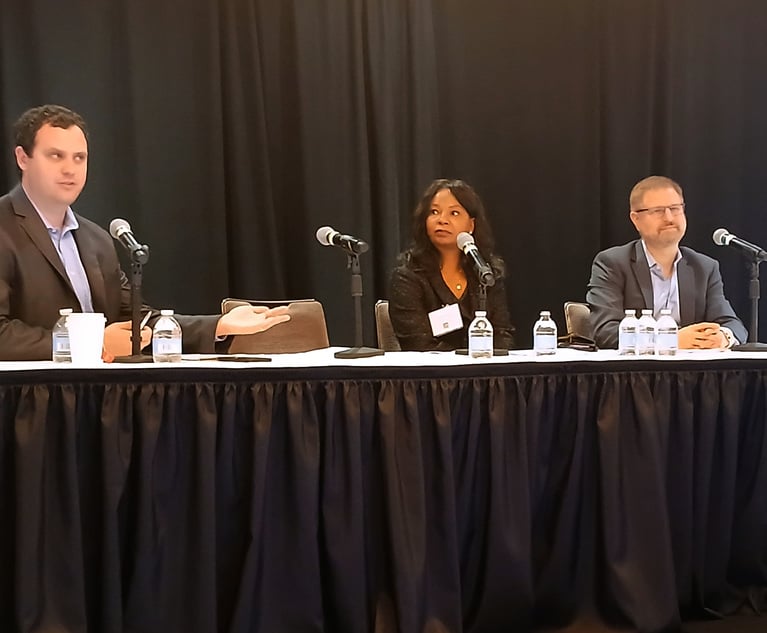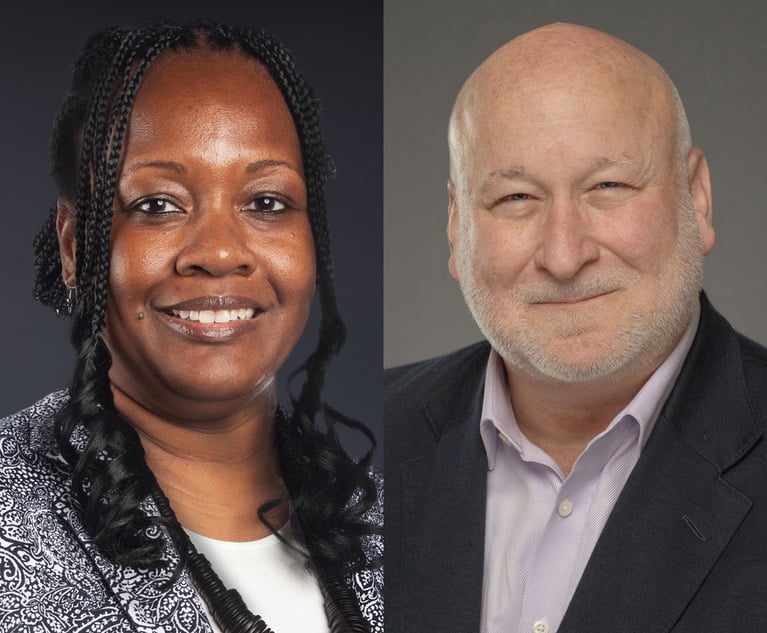Hidden Agenda
Proposals in health care bill send non-profits scrambling.
October 31, 2009 at 08:00 PM
7 minute read
The non-profit sector got a good look at sausage-making on Capitol Hill this fall during the health care debate. Whether the sector got ground up in the process is unknown at this writing, but the experience should not have been a surprise.
Will Rogers famously observed, “Congress meets tomorrow morning. Let us pray.” He could have been thinking about how a “must pass” piece of legislation can easily become a Christmas tree–it attracts lots of legislative “ornaments” in the form of amendments having nothing to do with the underlying bill. These ornaments tend to pop up seemingly out of nowhere, and do so at the last minute when scrutiny is weak because attention spans become short as Congress rushes to adjourn. Then odd things happen.
One of the odd things that happened sent the entire non-profit sector scurrying when it found among the 500 amendments proposed for the Senate's “must pass” health care bill a few that attempted to rewrite tax-exemption law.
An innocuous proposal was one from Sen. Chuck Grassley, R-Iowa. It would give explicit authority to the IRS to ask the several governance questions on the Form 990 we had to answer last year, even though the IRS admitted it had no authority to ask them (see “Passive-Aggressive Regulation,” March 2009). This led some charities to wonder what the consequences would be if they admitted on the form they did not have, for example, a conflict of interest policy or a document retention policy in place. There was talk of ignoring the questions. Some spoke of legal challenges. Grassley said he wanted to avoid “wasteful” litigation over the questions by inserting the provision in the health care bill. His proposal was essentially a technical change to which few would object.
Grassley went at it again with another amendment that addressed his well-known view that too many non-profit executives make too much money. The amendment would eliminate the safe harbor now in place for the calculation of reasonable executive compensation. The law now puts the burden on the IRS to challenge a non-profit's pay scheme if it is arrived at by following certain procedures. Apparently, Grassley and others didn't think this “rebuttable presumption” resulted in any real reduction of the alleged high salaries and perks, so they eliminated it. The rationale offered for the change was that it raised revenue.
The non-profit community had to scramble to thwart an idea some called cynical, misguided and divorced from reality. The primary objection was to using the complicated health care debate to effectively rewrite the compensation law for non-profits while avoiding any public debate on the issue. Opponents also said that if the change were to have the desired effect and result in significant cuts in executive pay, the Treasury would see a loss of revenue as incomes declined. Moreover, if the senator thought the extra revenue would come from the increased penalties executives pay under the system, he was mistaken there too, because it provided that the so-called “excess benefit” received by the executives be paid to the non-profit organization, not to the Treasury.
Finally, if Grassley really wanted to avoid “wasteful” litigation, the opponents pointed out, trying to eliminate the safe harbor on compensation was not the way to do it. The amendment would empower every IRS examiner to impose penalties whenever he thought a foundation, hospital or university CEO was overpaid. Tax lawyers warned it was a recipe for litigation disaster as an examiner's judgment was substituted for that of the board of directors, particularly if it was an independent board that relied on compensation comparables. The IRS's mediocre record in winning such lawsuits before the Tax Reform Act of 1986 did not help Grassley's case either, they claimed. And that's the story of just two links of the sausage.
The non-profit sector got a good look at sausage-making on Capitol Hill this fall during the health care debate. Whether the sector got ground up in the process is unknown at this writing, but the experience should not have been a surprise.
Will Rogers famously observed, “Congress meets tomorrow morning. Let us pray.” He could have been thinking about how a “must pass” piece of legislation can easily become a Christmas tree–it attracts lots of legislative “ornaments” in the form of amendments having nothing to do with the underlying bill. These ornaments tend to pop up seemingly out of nowhere, and do so at the last minute when scrutiny is weak because attention spans become short as Congress rushes to adjourn. Then odd things happen.
One of the odd things that happened sent the entire non-profit sector scurrying when it found among the 500 amendments proposed for the Senate's “must pass” health care bill a few that attempted to rewrite tax-exemption law.
An innocuous proposal was one from Sen. Chuck Grassley, R-Iowa. It would give explicit authority to the IRS to ask the several governance questions on the Form 990 we had to answer last year, even though the IRS admitted it had no authority to ask them (see “Passive-Aggressive Regulation,” March 2009). This led some charities to wonder what the consequences would be if they admitted on the form they did not have, for example, a conflict of interest policy or a document retention policy in place. There was talk of ignoring the questions. Some spoke of legal challenges. Grassley said he wanted to avoid “wasteful” litigation over the questions by inserting the provision in the health care bill. His proposal was essentially a technical change to which few would object.
Grassley went at it again with another amendment that addressed his well-known view that too many non-profit executives make too much money. The amendment would eliminate the safe harbor now in place for the calculation of reasonable executive compensation. The law now puts the burden on the IRS to challenge a non-profit's pay scheme if it is arrived at by following certain procedures. Apparently, Grassley and others didn't think this “rebuttable presumption” resulted in any real reduction of the alleged high salaries and perks, so they eliminated it. The rationale offered for the change was that it raised revenue.
The non-profit community had to scramble to thwart an idea some called cynical, misguided and divorced from reality. The primary objection was to using the complicated health care debate to effectively rewrite the compensation law for non-profits while avoiding any public debate on the issue. Opponents also said that if the change were to have the desired effect and result in significant cuts in executive pay, the Treasury would see a loss of revenue as incomes declined. Moreover, if the senator thought the extra revenue would come from the increased penalties executives pay under the system, he was mistaken there too, because it provided that the so-called “excess benefit” received by the executives be paid to the non-profit organization, not to the Treasury.
Finally, if Grassley really wanted to avoid “wasteful” litigation, the opponents pointed out, trying to eliminate the safe harbor on compensation was not the way to do it. The amendment would empower every IRS examiner to impose penalties whenever he thought a foundation, hospital or university CEO was overpaid. Tax lawyers warned it was a recipe for litigation disaster as an examiner's judgment was substituted for that of the board of directors, particularly if it was an independent board that relied on compensation comparables. The IRS's mediocre record in winning such lawsuits before the Tax Reform Act of 1986 did not help Grassley's case either, they claimed. And that's the story of just two links of the sausage.
This content has been archived. It is available through our partners, LexisNexis® and Bloomberg Law.
To view this content, please continue to their sites.
Not a Lexis Subscriber?
Subscribe Now
Not a Bloomberg Law Subscriber?
Subscribe Now
NOT FOR REPRINT
© 2024 ALM Global, LLC, All Rights Reserved. Request academic re-use from www.copyright.com. All other uses, submit a request to [email protected]. For more information visit Asset & Logo Licensing.
You Might Like
View All
Lawyers Drowning in Cases Are Embracing AI Fastest—and Say It's Yielding Better Outcomes for Clients

GC Conference Takeaways: Picking AI Vendors 'a Bit of a Crap Shoot,' Beware of Internal Investigation 'Scope Creep'
8 minute read
Why ACLU's New Legal Director Says It's a 'Good Time to Take the Reins'
Trending Stories
- 14th DCA: 'Trial Court Erred;' Big Law Partial Victory after $82M Flo Rida Verdict Appeal
- 2Dispute Over Failure to Accommodate Disability Ends in $900K Settlement
- 3FTC, DOJ Withdrawal of Antitrust Guidelines for Collaboration Infuriates Republicans
- 4HSF Leadership Removes Partner Over ‘Deeply Offensive’ Tweets
- 5House Passes Bill to Add Federal Judgeships in Face of Biden Veto Threat
Who Got The Work
Michael G. Bongiorno, Andrew Scott Dulberg and Elizabeth E. Driscoll from Wilmer Cutler Pickering Hale and Dorr have stepped in to represent Symbotic Inc., an A.I.-enabled technology platform that focuses on increasing supply chain efficiency, and other defendants in a pending shareholder derivative lawsuit. The case, filed Oct. 2 in Massachusetts District Court by the Brown Law Firm on behalf of Stephen Austen, accuses certain officers and directors of misleading investors in regard to Symbotic's potential for margin growth by failing to disclose that the company was not equipped to timely deploy its systems or manage expenses through project delays. The case, assigned to U.S. District Judge Nathaniel M. Gorton, is 1:24-cv-12522, Austen v. Cohen et al.
Who Got The Work
Edmund Polubinski and Marie Killmond of Davis Polk & Wardwell have entered appearances for data platform software development company MongoDB and other defendants in a pending shareholder derivative lawsuit. The action, filed Oct. 7 in New York Southern District Court by the Brown Law Firm, accuses the company's directors and/or officers of falsely expressing confidence in the company’s restructuring of its sales incentive plan and downplaying the severity of decreases in its upfront commitments. The case is 1:24-cv-07594, Roy v. Ittycheria et al.
Who Got The Work
Amy O. Bruchs and Kurt F. Ellison of Michael Best & Friedrich have entered appearances for Epic Systems Corp. in a pending employment discrimination lawsuit. The suit was filed Sept. 7 in Wisconsin Western District Court by Levine Eisberner LLC and Siri & Glimstad on behalf of a project manager who claims that he was wrongfully terminated after applying for a religious exemption to the defendant's COVID-19 vaccine mandate. The case, assigned to U.S. Magistrate Judge Anita Marie Boor, is 3:24-cv-00630, Secker, Nathan v. Epic Systems Corporation.
Who Got The Work
David X. Sullivan, Thomas J. Finn and Gregory A. Hall from McCarter & English have entered appearances for Sunrun Installation Services in a pending civil rights lawsuit. The complaint was filed Sept. 4 in Connecticut District Court by attorney Robert M. Berke on behalf of former employee George Edward Steins, who was arrested and charged with employing an unregistered home improvement salesperson. The complaint alleges that had Sunrun informed the Connecticut Department of Consumer Protection that the plaintiff's employment had ended in 2017 and that he no longer held Sunrun's home improvement contractor license, he would not have been hit with charges, which were dismissed in May 2024. The case, assigned to U.S. District Judge Jeffrey A. Meyer, is 3:24-cv-01423, Steins v. Sunrun, Inc. et al.
Who Got The Work
Greenberg Traurig shareholder Joshua L. Raskin has entered an appearance for boohoo.com UK Ltd. in a pending patent infringement lawsuit. The suit, filed Sept. 3 in Texas Eastern District Court by Rozier Hardt McDonough on behalf of Alto Dynamics, asserts five patents related to an online shopping platform. The case, assigned to U.S. District Judge Rodney Gilstrap, is 2:24-cv-00719, Alto Dynamics, LLC v. boohoo.com UK Limited.
Featured Firms
Law Offices of Gary Martin Hays & Associates, P.C.
(470) 294-1674
Law Offices of Mark E. Salomone
(857) 444-6468
Smith & Hassler
(713) 739-1250







